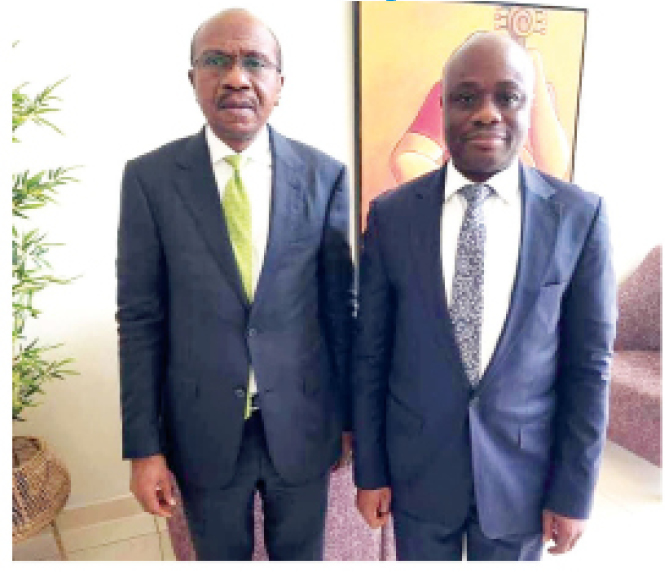Mixed reactions over possible interest rate hike as CBN’s monetary committee meets
Most central banks across the world have increased their benchmark interest rates within the last quarter in order to stifle inflationary momentum. This happens as the US dollar has already experienced significant appreciation in value this year in response to previous rate hikes. Residents Displaced as floods take over Yobe communities BoT appeals to Kwarans […]

From left: Governor, Central Bank of Nigeria, Mr. Godwin Emefiele; and President/Chairman of Council, The Chartered Institute of Bankers of Nigeria, Dr. Ken Opara; during the CIBN Stakeholders engagement with the CBN Governor in Lagos recently
Most central banks across the world have increased their benchmark interest rates within the last quarter in order to stifle inflationary momentum.
This happens as the US dollar has already experienced significant appreciation in value this year in response to previous rate hikes.
Residents Displaced as floods take over Yobe communities
BoT appeals to Kwarans to save central mosque from degradation
The dollar recently reached equal parity with the Euro for the first time in two decades as recession fears and rising rates continue to fuel a rush for the greenback.
The surge in the dollar’s value comes at the expense of other currencies, especially those from emerging markets and developing economies (EMDE’s). Nigeria being an important dependent country is heavily reliant on the import of commodities priced in dollars. As the value of the dollar rises and these dollar priced commodities become more expensive for holders of other currencies such as the naira, high incidences of imported inflation will arise and weigh on the spending power of domestic consumers.
Nigeria’s headline inflation rose by 0.84% to 18.6%, from 17.75% in May. This is the 5th consecutive monthly increase and the highest inflation rate since January 2017
As with the past few months, the exorbitant price of diesel remains the chief contributor to spiralling inflation in Nigeria. Diesel price has surged by approximately 278% (year-to-date), pushing up transportation and logistics costs as well as the general cost of running businesses across the country.
Additionally, the negative effects of biting dollar scarcity and the persistent depreciation in the value of the naira are compounding energy cost constraints to create a perfect inflationary storm.
Analysts at Financial Derivative said: “We expect at least a 50bps hike from the MPC/CBN at its next policy meeting scheduled for July 18 & 19.
This would be in line with international trends and align with the CBN’s mandate to fight inflation.”
However, Analysts at Afrinvest are of the view that despite the increase in MPR in May 2022, the hike failed to have an immediate impact on inflation due to weak and delayed transmission mechanism of monetary policy.
One of them said: “We believe the MPC would maintain status-quo on MPR at its next meeting brought forward to July 18 and 19, despite domestic price & FX pressure and the strong possibility of a sharper interest rate hike by the US Feds in July.”
The Analysts’ hold-steady outlook is premised on the expectation that the committee would prefer to give more time to assess the impact of the last policy change (+150bps hike in May) on price dynamics (at least till September).
They said: “While we expect a hold-steady outlook, it is our opinion that the MPC should adjust the asymmetric corridor to support the transmission impact of the MPR on financial system liquidity and domestic inflation.”
Analysts at Cordros Research expect the committee to examine the global economy’s health within the context of continued monetary policy tightening by global central banks and the lingering spillover effects of the spat between Russia and Ukraine.
In the analysts’ view, the committee will likely stress the need to examine the global economy’s health in the near term and how the global central banks would react correspondingly, given that the downside risks to global growth have intensified.
On the domestic front, they believe near-term inflation expectations will likely discomfort committee members, given the pass-through impact of elevated global energy prices on headline inflation.
“Moreover, we expect the committee to maintain a cautious outlook on the domestic growth pace given the spillover impact of an impending global growth slowdown on the domestic economy amidst supply-side driven domestic inflationary pressures,“ they added.
On balance, the analysts expect the committee to retain the MPR at 13.0% alongside other monetary policy parameters to allow previous policy actions to permeate the economy.
However, they also expect the committee’s tone to be hawkish in the light of the tightening of monetary policy by global central banks and the election spending effect on inflationary pressures.
